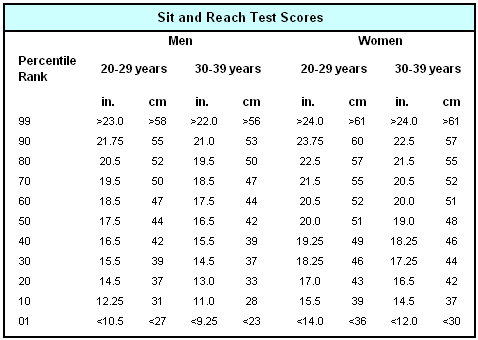Modified Sit And Reach Test
The sit and reach test is the most common flexibility test. It measures
the flexibility of the lower back and hamstrings. It requires a box about 30cm (12 inches) high and a meter rule:
1. Sit on the floor with your back and head against a wall. Legs should
be out straight ahead and knees flat against the floor.
2. Have someone place the box flat against your feet (no shoes). Keeping
your back and head against the wall stretch your arms out towards the box.
3. Have someone place the ruler on the box and move the zero end towards
your fingertips. When the ruler touches you fingertips you have the zero point
and the test can begin.
4. Lean forward slowly as far as possible keeping the fingertips level with
each other and the legs flat. Your head and shoulders can come away from the wall now. Do NOT jerk or bounce to reach further.
5. Slowly reach along the length of the ruler 3 times. On the third attempt
reach as far as possible and hold for 2 seconds. Have your training partner read the score. Repeat twice and compare your
best score with the table below.
The following table is data from the American College of Sports Medicine
(1995) for performance in the sit and reach test:

Trunk
Rotation Test
This flexibility test measures trunk and shoulder flexibility. The only equipment required is a wall and a piece of chalk or pencil.
1. Mark a vertical line on the wall. Stand with your back to the wall directly in front of the line. You should be about
arms length away from the wall with your feet shoulder width apart.
2. Extend your arms out directly in front of you so they are parallel to the floor. Twist your trunk to your right and
the touch the wall behind you with your fingertips. Your arms should stay extended and parallel to the floor. You can turn
your shoulders, hips and knees as long as your feet don't move.
3. Mark the position where your fingertips touched the wall. Measure the distance from the line. A point before the line
is a negative score and a point after the line is a positive score.
4. Repeat for the left side and take the average of the 2 scores and compare with the table below:
|
Trunk Rotation Test |
|
Poor |
Fair |
Good |
Very good |
Excellent |
|
|
0cm |
5cm |
10cm |
15cm |
20cm |
|



